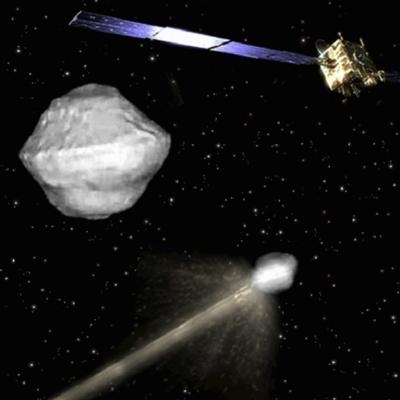Fri, Jan 18, 2013
Seeking Improved Understanding Of High-Speed Collisions Between Natural And Man-Made Objects
A space rock several hundred metres across is heading towards our planet and the last-ditch attempt to avert a disaster – an untested mission to deflect it – fails. This fictional scene of films and novels could well be a reality one day. But what can space agencies do to ensure it works?

ESA is seeking research ideas to help guide the development of a US–European asteroid deflection mission now under study.
Concepts are being sought for both ground- and space-based investigations, seeking improved understanding of the physics of very high-speed collisions involving both man-made and natural objects in space. ESA’s call will help to guide future studies linked to the Asteroid Impact and Deflection mission – AIDA. This innovative but low-budget transatlantic partnership involves the joint operations of two small spacecraft sent to intercept a binary asteroid. The first Double Asteroid Redirection Test (DART) spacecraft, designed by the US Johns Hopkins Applied Physics Laboratory will collide with the smaller of the two asteroids.
Meanwhile, ESA’s Asteroid Impact Monitor (AIM) craft will survey these bodies in detail, before and after the collision. The impact should change the pace at which the objects spin around each other, observable from Earth. But AIM’s close-up view will ‘ground-truth’ such observations. “The advantage is that the spacecraft are simple and independent,” says Andy Cheng of Johns Hopkins, leading the AIDA project on the US side. “They can both complete their primary investigation without the other one.”
But by working in tandem, the quality and quantity of results will increase greatly, explains Andrés Gálvez, ESA AIDA study manager: “Both missions become better when put together – getting much more out of the overall investment. “And the vast amounts of data coming from the joint mission should help to validate various theories, such as our impact modeling.”
(ESA image artist's concept of AIDA mission)
More News
Inversion to Launch Reentry Vehicle Demonstrator Aboard SpaceX Falcon 9 This fall, the aerospace startup Inversion is set to launch its Ray reentry demonstrator capsule aboard Spac>[...]
"We are excited to accelerate the adoption of electric aviation technology and further our journey towards a sustainable future. The agreement with magniX underscores our commitmen>[...]
"The journey to this achievement started nearly a decade ago when a freshly commissioned Gentry, driven by a fascination with new technologies and a desire to contribute significan>[...]
Aero Linx: OX5 Aviation Pioneers Each year a national reunion of OX5 Aviation Pioneers is hosted by one of the Wings in the organization. The reunions attract much attention as man>[...]
"Our driven and innovative team of military and civilian Airmen delivers combat power daily, ensuring our nation is ready today and tomorrow." Source: General Duke Richardson, AFMC>[...]
 SpaceX to Launch Inversion RAY Reentry Vehicle in Fall
SpaceX to Launch Inversion RAY Reentry Vehicle in Fall Aero-News: Quote of the Day (04.23.24)
Aero-News: Quote of the Day (04.23.24) Aero-News: Quote of the Day (04.20.24)
Aero-News: Quote of the Day (04.20.24) ANN's Daily Aero-Linx (04.20.24)
ANN's Daily Aero-Linx (04.20.24) Aero-News: Quote of the Day (04.21.24)
Aero-News: Quote of the Day (04.21.24)



